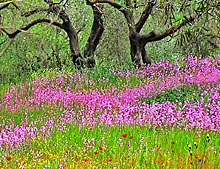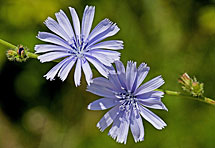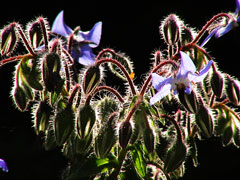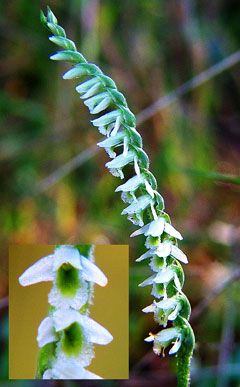 Olive grove poppies |
|
| March and April are undoubtedly
the best months on Corfu for wild flowers with May through
to June somewhat less prolific. In July and August most plants have either produced seed and withered, or retired beneath the surface into bulbs and tubers. Evidence of this can be seen everywhere in the tinder dry remnant stalks of once beautiful flowers. September onwards often seems like a second spring though not as spectacular as March and April, with many plants making a colourful debut or encore after the long hot and dry summer months. From mid October due to the high rainfall and acceptable temperatures, most herbaceous plants take advantage and produce foliage more akin to that which appears in April in the northern climes. Even in the depths of the northern winter, on Corfu, some so called spring flowers are happily blossoming, to bring the occasional diversion to an otherwise lacklustre winter walk.
|
|
 May |
Spring. In springtime, the variety and profusion of flowers and foliage in some places is done in an English cottage garden like style, which has to be seen to be appreciated. Pathways and clearings in the olive groves come alive with wild Tulips, Iris, Bluebells, Poppies and a variety of flowering plants found in Northern Europe but here their flowers colours appear more vivid, scent more intense and foliage even more succulent. Also the wild cousin of our cultivated Chrysanthemums, Lupins, Geraniums, Crocus, Asphodel and Gladioli can be found in fields, ditches and even by the roadside. Ipomoea or Morning Glory drapes itself over fences and hedges and although the flowers only last a day nature replaces them with fresh blossoms every morning. |
| Other plants include the bright blue tinted Sea Holly, Sea Lavender, Heather’s and Oleander. Orchids, especially the Bee Orchid and the Fly Orchid start to flower in March and are at their best in April. Wisteria is in bloom as are the orange and lemon trees. | |
 Gladioli |
The Judas tree with its magenta flowers, blossoms before the leaves appear. Prickly pear presents a brash display of yellow flowers. In the woodlands the arum lily also called “Lords and Ladies” can be found peering out through the undergrowth and if you are lucky the telltale smell of rotten meat could lead you to the Snakeworth with its beautiful but strange purple, brown and green flower. The foul smell is its clever way to attract flies, which are necessary for pollination. Also in late spring Rockroses begin to display their pastel coloured pink and cream flowers, and Broomrape, a strange parasitic plant which lacks chlorophyll can be found in meadows, usually close to its host plant, clover. The olive groves have a fairy tale carpet of mosses, fungi, grasses and ferns, the favoured haunt of the tortoise, butterflies and woodland birds. |
 Venus looking glass |
Summer. Early in summer the spring flowers are beginning to recede but the overall impression on the island leans towards a lush subtropical type of landscape. The sea appears turquoise/azure blue, the foliage on the trees and bushes become more dense and the cicadas burrow to the surface and begin their summer long daytime chorus. Given the time of year it was traditional for the young men in Greece to make wreaths of wild flowers to win over the hearts of the ladies. As the hotter, drier months of July and August arrive the hardier plants appear such as the golden thistle (Scolymus hispanicus.) with its bright yellow flowers. Sea holly (Eryngium maritimum.) another thistle like plant can be found on sandy shorelines, it’s leaves a cross between holly and thistle. |
| Eryngium creticum a close
relation of the sea holly which inhabits the general
countryside, looks inconspicuous at first until July when
its thistle like leaves change from green to blue. From a
distance a colony of these plants in a clearing has the
appearance of a surreal blanket of blue mist. Along the roadside in the evening, night scented stock and jasmine spray their beautiful, lingering but invisible clouds of delicate scent. Thyme is abundant and its unmistakable smell explodes from underfoot making it relatively easy to identify. Wild mint grows truly wild and can be found almost everywhere. |
|
 Larkspur |
Mullein is in bloom with its large moleskin
textured leaves and spires of miniature primrose like
flowers. Mullein was once used as a type of fish poison.
Nigella damascena, which has numerous alternative names such
as “love in a mist” or “devil in a bush”, these names being
quite apt given the thorny, twig like veil surrounding the
flower. The chaste tree flowers all through the summer months and is a favourite of many butterflies and bees, its leaves and flowers are said to have anti-aphrodisiac properties, probably due to the disagreeable smell when crushed. Larkspur and honeywort seem to like semi shade and can frequently be seen beneath the olive trees, as can hairy flax with its striking pink and violet flowers. The Sea lily is in bloom in the later summer months but unfortunately is becoming rarer due to mankind’s pressure on its specialised habitat. |
| “There was, however, a certain
time of the year when the lake was at its best, and that was
the season of lilies. The smooth curve of the dune that ran
between the bay and the lake was the only place on the
island where these sand lilies grew, strange, misshapen
bulbs buried in the sand, that once a year sent up thick
green leaves and white flowers above the surface, so that
the dune became a glacier of flowers.” © Copyright -Gerald
Durrell (My family and other animals.)
The Sea Lily which is also known as the Sea Daffodil or Sand Lily is an attractive member of the amaryllis family. |
|
 Sea lily |
The Minoans of Crete held this plant
in high esteem. It flowers for a number of weeks from July
through to August when little else is in flower. The
distinctive pure white flowers are highly scented and
multiple blossoms appear on top of a 30 to 60-cm. stem. Its
normal habitat is sand dunes often only a few metres from
the breaking waves, hence its Greek name – Krinos tis
thalassas. This plant is quite rare due to its specialised habitat but can now be found in a number of locations on Corfu, most notably Antiniotissa and Korission.
|
| Autumn. If one plant were said to steal the show on Corfu in Autumn it is without doubt the Cyclamen. Clumps of them are to be found sprouting everywhere, even from a handful of soil in a fissure on the rocks. A number of varieties are to be found, some with plain ivy shaped leaves, others with large variegated leaves as pretty as the flowers themselves and again some with pink flowers and others with white. |
|
 Cyclamen |
Another unusual looking plant which springs to life in Autumn and persists well into the winter months is the Friars cowl (Arisarum vulgare). During autumn, the crocus also flowers, they seem to cohabit happily with the cyclamen and indeed their colouration is similar, but their blossoms are not as hardy and don’t last as long before wilting. Luckily they are numerous and fresh flowers are usually only a few steps away. Many of the autumn flowering plants persist well into the winter months and frequently overlap with some so called spring flowers on Corfu, due primarily to the usually mild and sometimes relatively warm daytime temperatures during the winter months. |
| Sea squill: - (Urginea maritima),
which is common throughout the Mediterranean, can regularly
be found in clearings of well-drained soil. It flowers in
October with spikes of blossoms 1mtr. In height from a
10-15cm. bulb which can weigh up to 2kg. The top of its bulb
usually protrudes from the soil surface. The plant contains
cardiac glycoside, which has similar medical properties to
digitalis, which is found in the foxglove and therefore very
dangerous to consume except under medical supervision. It is
used in the treatment of bronchitis and asthma. Was also
used as a form of rat poison and as such an effective
rodenticide, Arabs regularly planted Urginea around their
graves to protect them.
|
|
| Winter. Winters on Corfu are generally mild, bright sunny days are interspersed with days of overcast cloud. It is frequently wet and usually damp at night. Sub zero temperatures are very infrequent, although when they do occur, damage to some plants is evident in frost damage. Every few years a covering of snow can occur, |
|
 Snowdrop |
which generally would only last a day or two before melting. The foliage on the trees has thinned out dramatically, allowing more light through to the herbaceous plants below, which in conjunction with the rainfall, gives rise to an eruption of greenery. Beneath the olive trees, which fruit every second year, this growth will have been cut down to facilitate the laying of nets in order to harvest the fruit. In spite of this there will still be something of interest to see. Some of the notable winter flowering plants include: Anemones, in mauve, scarlet and white are common, whilst cyclamen and crocus are still to be found. Wild almond blooms during winter in shades of pink or white. Narcissi and the rare Corfu snowdrop can be seen from November onwards, at times even by the roadside. |
| Horta: A traditional pastime, which is today still as important and popular, is gathering “Horta”. This is an activity carried out from October to May and involves the picking of a |
|
 Chicory |
variety of edible plants including Dandelion, Wild Mustard, Neapolitan Garlic, Honeywort, Borage, Wild Asparagus and Chicory. Many families have a favoured area on which they gather what they regard as the best horta. Indeed some people will allow “ weeds “ to grow in their gardens in order to have a readily available supply of their favourite plants. These are then boiled, covered in olive oil and served with potatoes, feta, fish and bread or whatever else is available to constitute a substantial meal. |
| The only tools necessary to partake in this activity are a plastic bag and sharp kitchen knife. | |
 Borage |
The island is also inundated with a great
selection of herbal plants, which the islanders have
utilised to their benefit. Amongst them Oregano is gathered
by every household in June just as the flowers begin to
bloom, they are then cleaned in water and hung in the shade.
After a week or two the flower heads are removed when dry,
this is known as “rigani” which is used copiously in the
Corfiot kitchen. Bay and Mint along with Wild Celery are
also part of the natural bounty of this fertile island.
|
| ORCHIDS There are also a number of unusual plants including Orchids, of which there are about 36 species on Corfu some of them endangered, this is exceptional considering the whole British isles contains only between 40 an 50 species. Orchids on Corfu include Spiranthes spiralis which has greenish white flowers around the stem like plaited hair, less than 12 inches tall. Also Orphrys reinholdii a beautiful purple orchid with a horseshoe printed in white and the Bee orchid, which is also to be found in northern Europe. |
|
 Ladys tresses |
Lady’s Tresses: - ( spiranthes spiralis. ) This diminutive plant is Corfu’s only autumn flowering orchid. The name is due to its resemblance to a lady’s plaited hair. Although widespread in Europe it is classed as rare with colonies of usually less than ten plants. Prefers grassy clearings in pine forests near the coast. Flowers during September and October, plants are less than 30 cm. tall and the tiny flowers only 5 mm. It is said to give off an almond like scent in the evenings. Historically the plant was used as an aphrodisiac and as a homeopathic remedy for some skin and eye afflictions.
Note: Due to their increasing rarity great care must be taken so as not to disturb these plants in their natural haitat and under no circumstances should the flower heads be picked. Please watch your step when taking photographs. |
|
|
|
| Download PDF version of this website with more photographs etc. in the downloads section. | |









